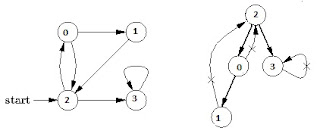Given a directed graph, chech whether the graph contain a cycle or not. Your method should return true if the given graph have atleast one cycle, else return false. For example the following graph have 3 cycle 2 -> 0 ->2, 2 -> 0-> 1 ->2, and 3 -> 3. so your method must return true. Depth first Search(DFS) of a tree can be used to detect a cycle in a Graph. If DFS is applied over a directed and connected graph, it gives a tree. If tree contains a back edge, we can say graph has a cycle.
Back edge in a Graph
 Consider an edge (u,v) is said to be a back edge, if node 'v' is an ancestor of node 'u' in a tree when DFS
applied. Basically, a back edge is an edge which is from a node to itself(self loop) or to an ancestor. In the
given graph, there are 3 back edges, marked with cross sign.
We can observe that 3 back edges indicate that 3 cycle present in a graph.
Consider an edge (u,v) is said to be a back edge, if node 'v' is an ancestor of node 'u' in a tree when DFS
applied. Basically, a back edge is an edge which is from a node to itself(self loop) or to an ancestor. In the
given graph, there are 3 back edges, marked with cross sign.
We can observe that 3 back edges indicate that 3 cycle present in a graph.
Java program to detect cycle in directed graph
To detect a cycle in a directed graph, we need to detect back edge. We will store the vertices in recursion stack of DFS traversal. If we reach a vertex that is already in the recursion stack, then there is a cycle in the tree. The edge that connects current vertex to the vertex in the recursion stack is back edge. We have used recStack[] array to keep track of vertices in the recursion stack.
package com.walking.techie.data.structure.graph;
import java.util.Iterator;
import java.util.LinkedList;
//java program to detect cycle in directed graph
public class DetectCycleInDirectedGraph {
private int v; // no of vertices in a graph
private LinkedList<Integer> adj[];// array of linked list if adjacency list
// representation
public DetectCycleInDirectedGraph(int v) {
this.v = v;
adj = new LinkedList[v];
for (int i = 0; i < v; i++) {
adj[i] = new LinkedList<Integer>();
}
}
public static void main(String[] args) {
DetectCycleInDirectedGraph g = new DetectCycleInDirectedGraph(4);
g.addEdge(0, 1);
g.addEdge(0, 2);
g.addEdge(1, 2);
g.addEdge(2, 0);
g.addEdge(2, 3);
g.addEdge(3, 3);
if (g.isCyclic()) {
System.out.println("Graph contain cycle.");
} else {
System.out.println("Graph doesn't contain cycle.");
}
}
// addEdge method to add edge between vertex i and vertex j
public void addEdge(int i, int j) {
adj[i].add(j);
}
public boolean isCyclic() {
// mark all the vertices not visited
boolean visited[] = new boolean[this.v];
boolean recStack[] = new boolean[this.v];
for (int i = 0; i < this.v; i++) {
if (isCyclicUtil(i, visited, recStack)) {
return true;
}
}
return false;
}
private boolean isCyclicUtil(int i, boolean[] visited, boolean[] recStack) {
//mark current node as visited and part of recursion stack
visited[i] = true;
recStack[i] = true;
Iterator<Integer> itr = adj[i].iterator();
while (itr.hasNext()) {
int n = itr.next();
if (!visited[n] && isCyclicUtil(n, visited, recStack)) {
return true;
} else if (recStack[n]) {
return true;
}
}
recStack[i] = false; // remove the vertex from recursion stack
return false;
}
}
Output of above program is shown below:
Graph contain cycle.
Note : This code has been compiled and run on mac notebook and intellij IDEA.



No comments :
Post a Comment